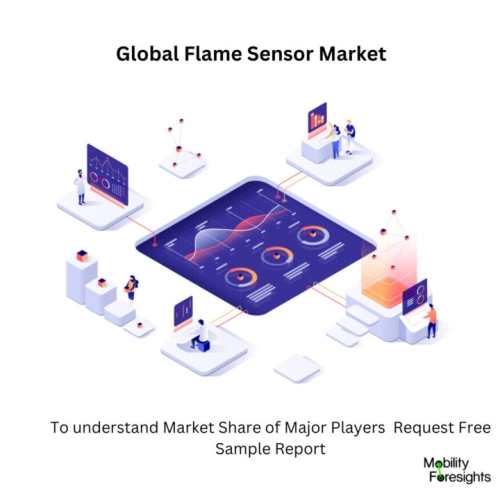
- Get in Touch with Us

Last Updated: Apr 25, 2025 | Study Period:
A flame detector is a sensor created to recognize the presence of a flame or fire and act accordingly, enabling flame detection. Depending on the installation, possible responses to flame detection include sounding an alarm, turning off a fuel line (such as a propane or a natural gas line), and turning on a fire suppression system.
When employed in industrial furnaces, for example, their purpose is to certify that the furnace is operating properly. They can also be used to turn off the ignition system, however frequently they don't do anything more than alert the operator or control system.
Due to the techniques, it employs to detect the flame, a flame sensor frequently has a faster response time and more accuracy than a smoke or heat detector.
UV detectors operate by capturing the UV radiation released at the moment of ignition. Although capable of fire and explosion detection in 3â4 milliseconds, a time delay of 2â3 seconds is frequently included to reduce false alarms that may be caused by other UV sources, such as lightning, arc welding, radiation, and sunshine.
To reduce the impact of ambient background radiation, UV detectors typically operate at wavelengths less than 300 nm. Oily pollutants are also capable of easily blinding the solar-blind UV wavelength band.
Visual flame detectors, often referred to as near-infrared (IR) array flame detectors (0.7 to 1.1 m), use flame identification technology to detect fire by analyzing near IR radiation with a charge-coupled device (CCD). A near-infrared (IR) sensor can see flame phenomena with little to no interference from water or water vapor.
At this wavelength, pyroelectric sensors can be rather affordable. Arguably the most dependable methods for fire detection are multiple channel or pixel array sensors that watch for flames in the near IR range.
A fire's light output creates an image of the flame at a specific moment. By analyzing the video produced from the near IR pictures, digital image processing can be used to identify fires.

The Global flame sensor market accounted for $XX Billion in 2022 and is anticipated to reach $XX Billion by 2030, registering a CAGR of XX% from 2024 to 2030.
For the security of oil and gas refineries, chemical industries, gasoline stations, and other locations controlling huge volumes of gas, MSA has developed a new General Monitors FL500-H2 flame sensor.
A colorless, odorless, highly combustible gas called hydrogen (H2) is compressed under pressure and kept in tanks for use in industry. The oxygen in the air makes the gas very flammable and hazardous if it escapes the tank storing it and is let loose. Accidents at plants can become disastrous if hydrogen leaks go undetected.
An ultraviolet/infrared (UV/IR) flame detector called the FL500-H2 is intended to find H2 fires. The sensors track the optical radiation that an H2 flame emits in the UV and IR spectral bands while simultaneously excluding sources that frequently cause false alarms on industrial construction sites.
The UV sensor is used by the detector's flame sensing technology to deliver a speedy response (less than 3 seconds), while the IR detector tracks the radiation emitted by a flame over a broad 130° field-of-view. UV/IR sensor technology is suitable for both indoor and outdoor use, operates at quicker speeds, and provides enhanced immunity.
| Sl no | Topic |
| 1 | Market Segmentation |
| 2 | Scope of the report |
| 3 | Abbreviations |
| 4 | Research Methodology |
| 5 | Executive Summary |
| 6 | Introduction |
| 7 | Insights from Industry stakeholders |
| 8 | Cost breakdown of Product by sub-components and average profit margin |
| 9 | Disruptive innovation in the Industry |
| 10 | Technology trends in the Industry |
| 11 | Consumer trends in the industry |
| 12 | Recent Production Milestones |
| 13 | Component Manufacturing in US, EU and China |
| 14 | COVID-19 impact on overall market |
| 15 | COVID-19 impact on Production of components |
| 16 | COVID-19 impact on Point of sale |
| 17 | Market Segmentation, Dynamics and Forecast by Geography, 2024-2030 |
| 18 | Market Segmentation, Dynamics and Forecast by Product Type, 2024-2030 |
| 19 | Market Segmentation, Dynamics and Forecast by Application, 2024-2030 |
| 20 | Market Segmentation, Dynamics and Forecast by End use, 2024-2030 |
| 21 | Product installation rate by OEM, 2023 |
| 22 | Incline/Decline in Average B-2-B selling price in past 5 years |
| 23 | Competition from substitute products |
| 24 | Gross margin and average profitability of suppliers |
| 25 | New product development in past 12 months |
| 26 | M&A in past 12 months |
| 27 | Growth strategy of leading players |
| 28 | Market share of vendors, 2023 |
| 29 | Company Profiles |
| 30 | Unmet needs and opportunity for new suppliers |
| 31 | Conclusion |
| 32 | Appendix |